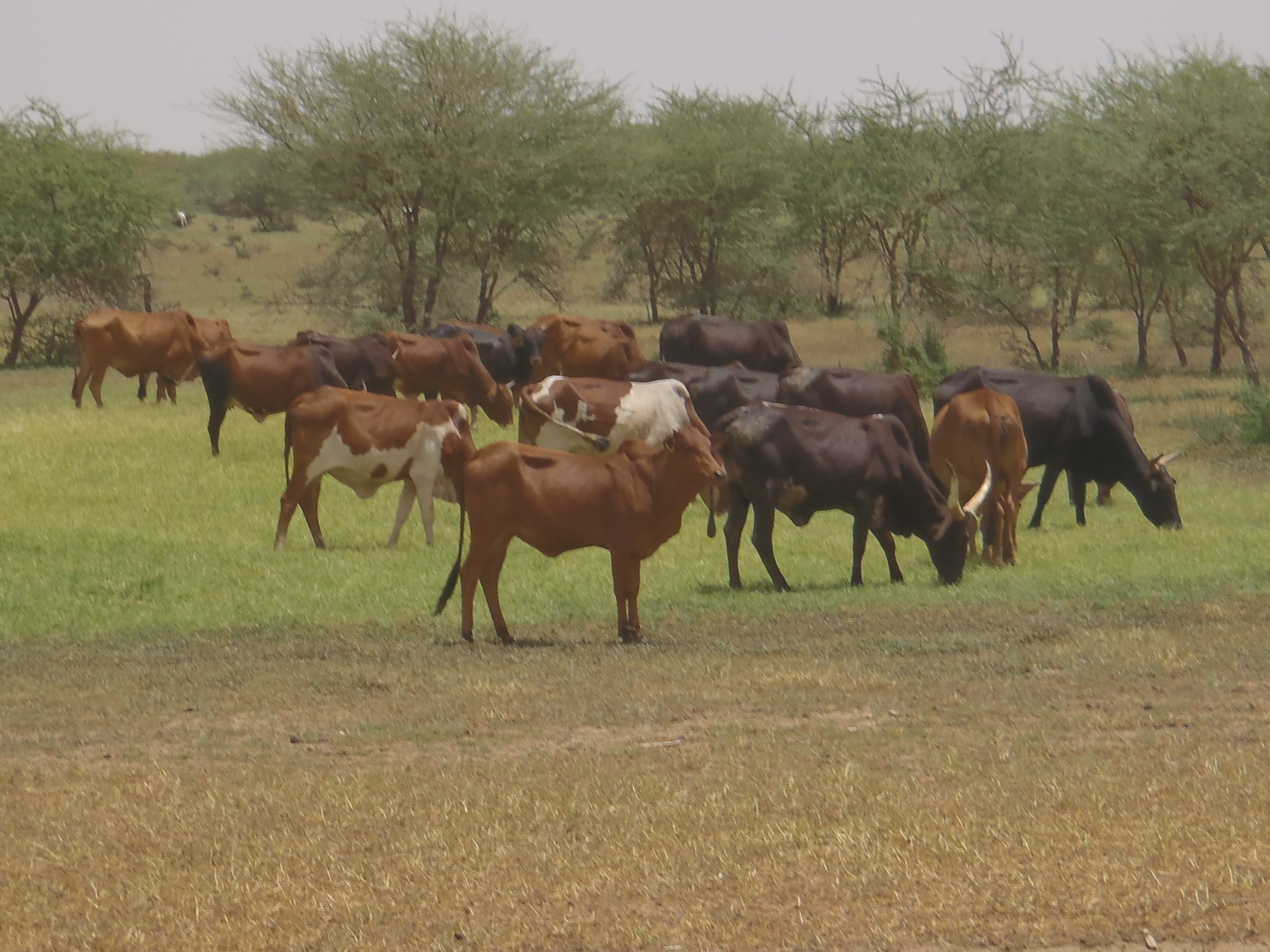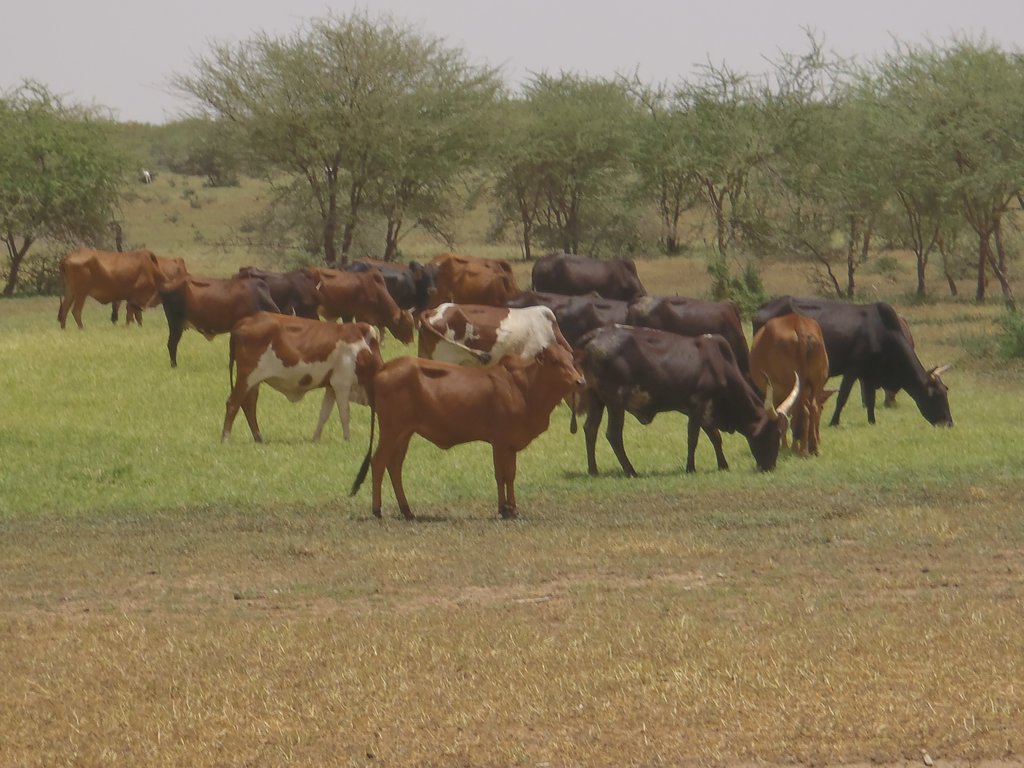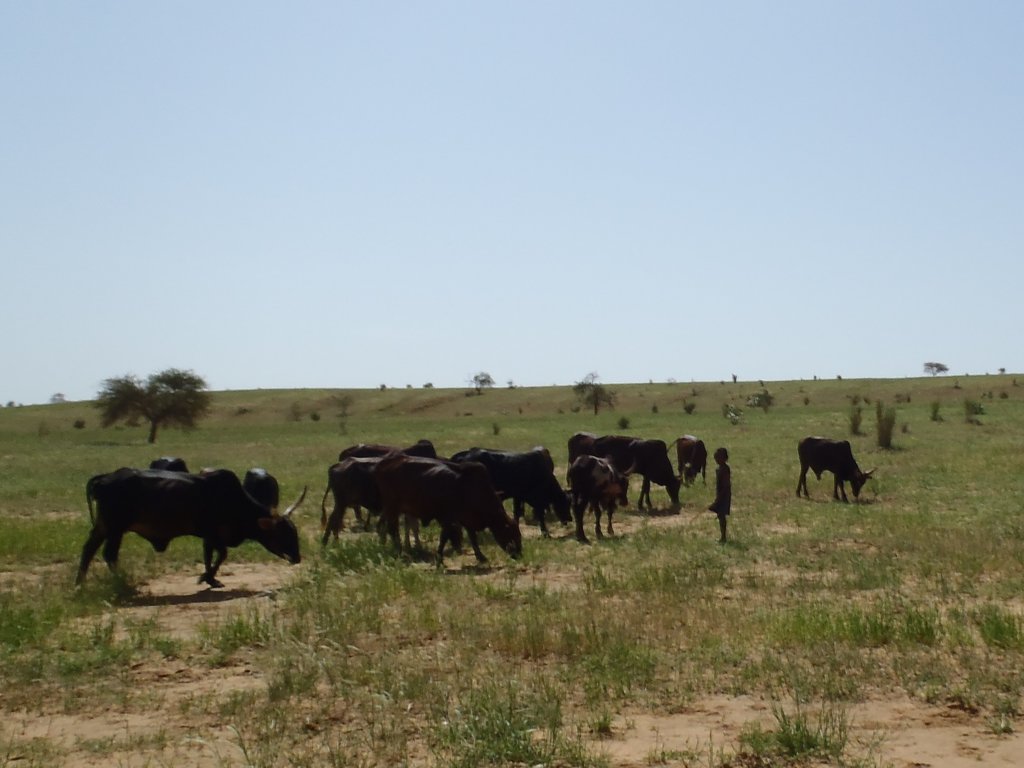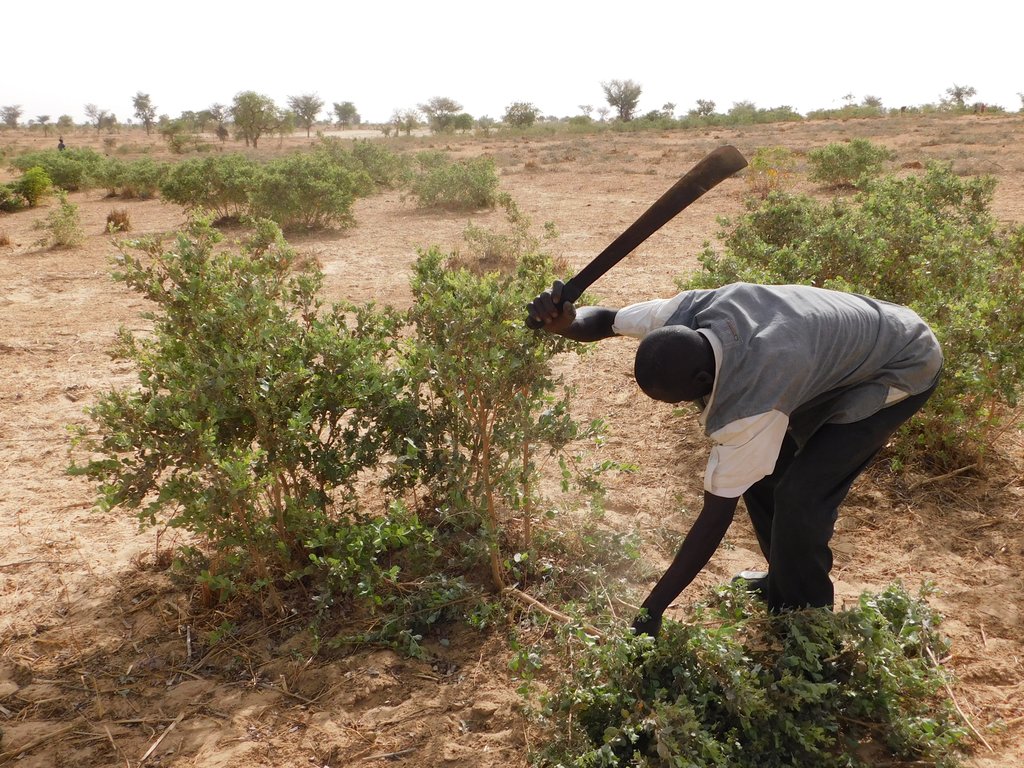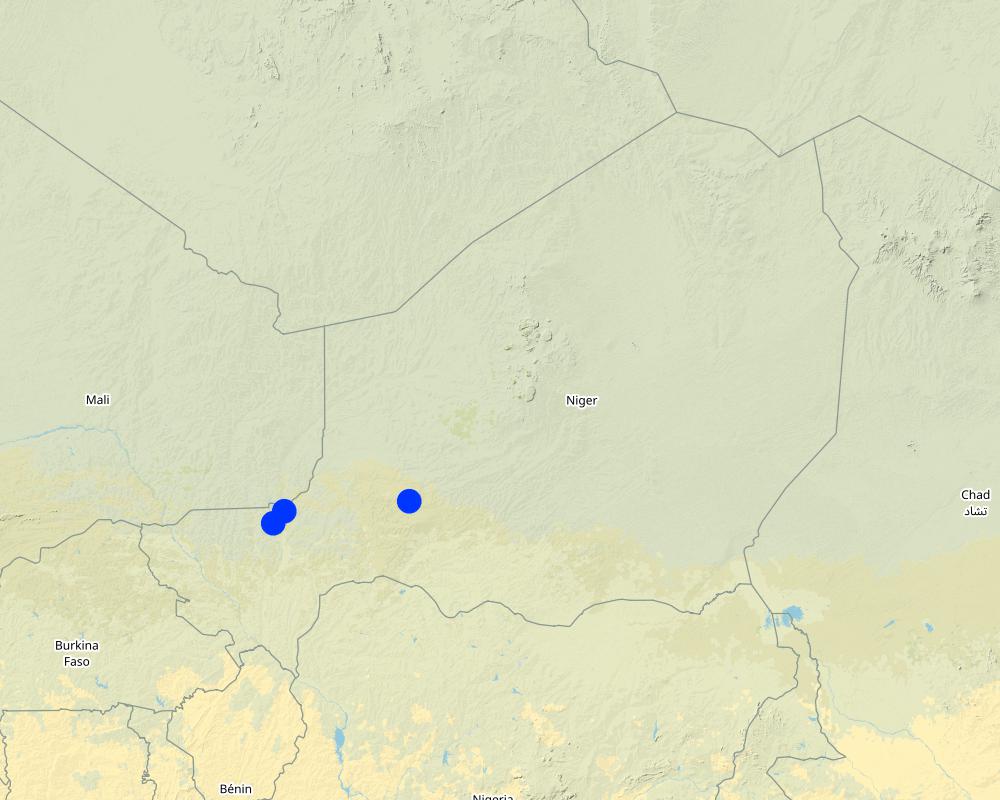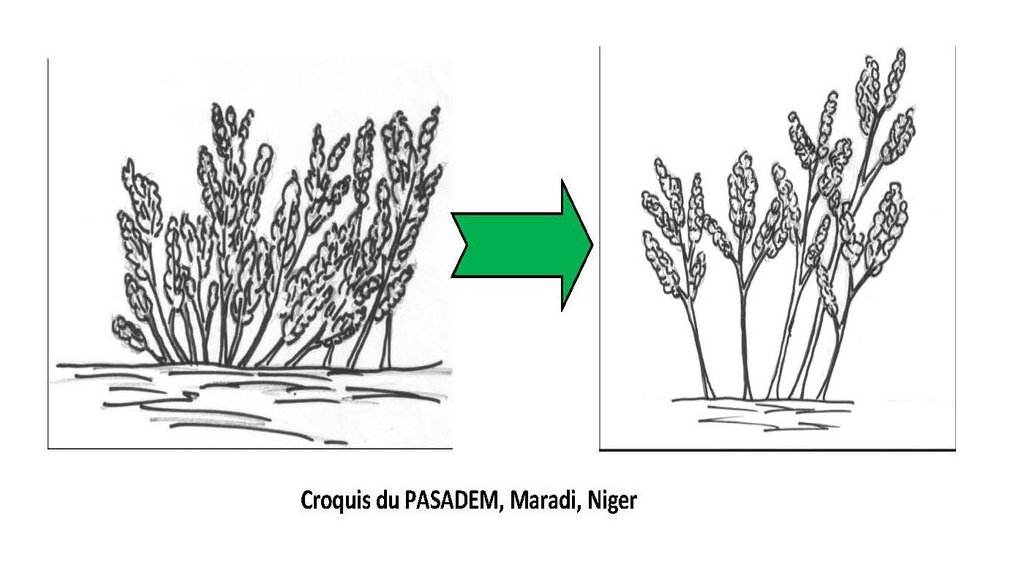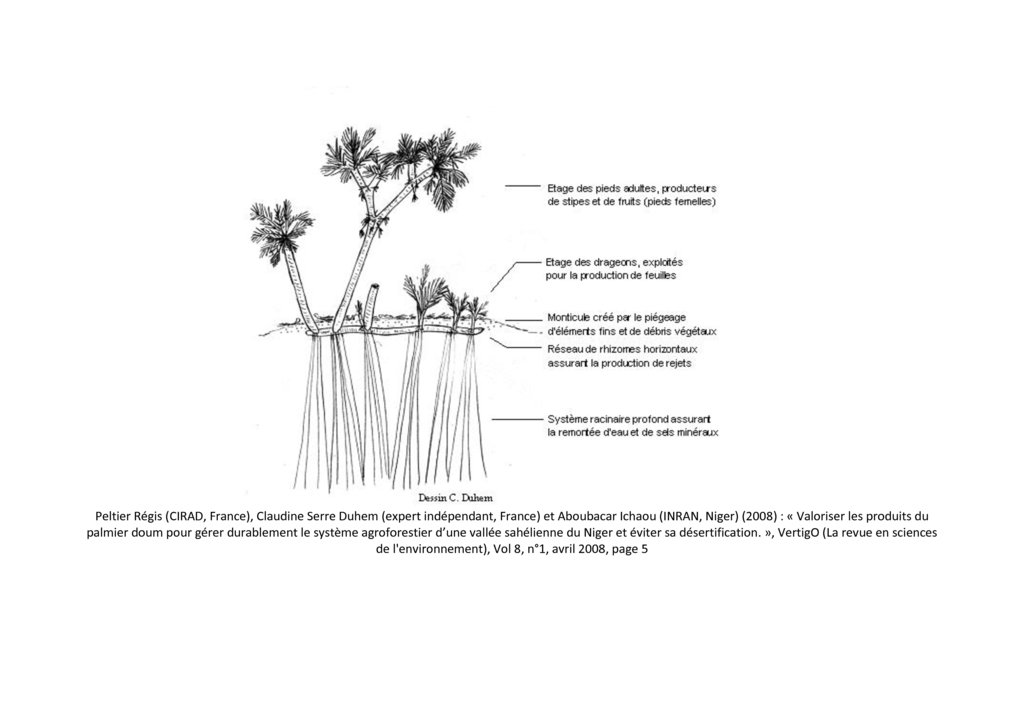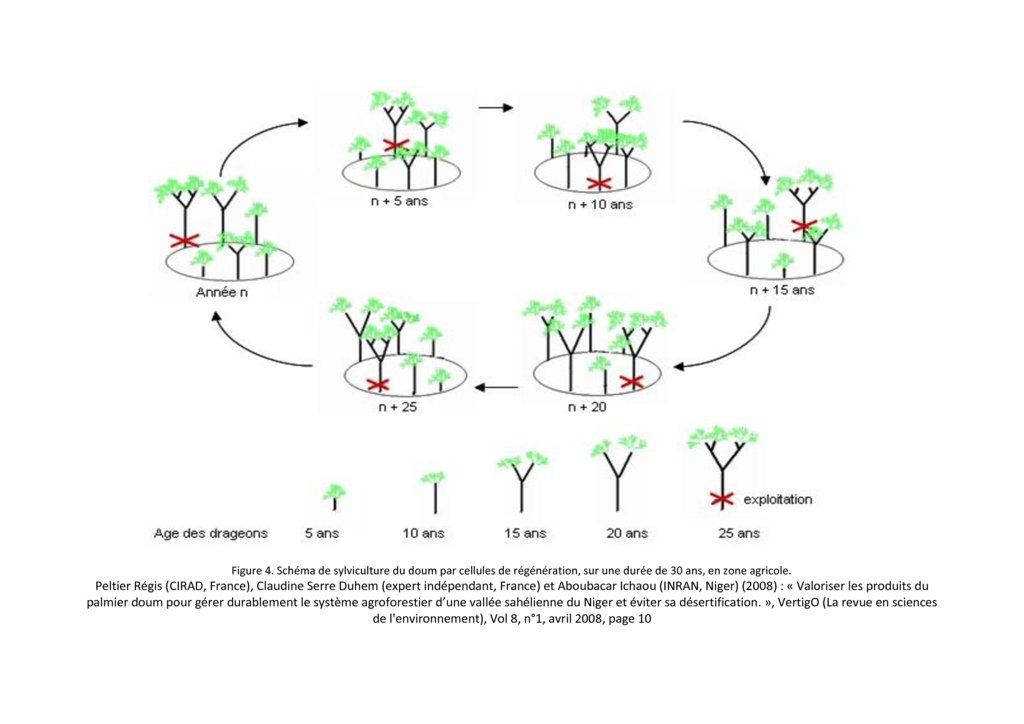Assisted Natural Regeneration on agro-pastoral, sylvo-pastoral and pastoral land [Niger]
- Creation:
- Update:
- Compiler: Soumaila Abdoulaye
- Editor: –
- Reviewers: Alexandra Gavilano, Donia Mühlematter, Rima Mekdaschi Studer, Simone Verzandvoort, Joana Eichenberger
technologies_2325 - Niger
- Full summary as PDF
- Full summary as PDF for print
- Full summary in the browser
- Full summary (unformatted)
- Assisted Natural Regeneration on agro-pastoral, sylvo-pastoral and pastoral land: June 12, 2019 (inactive)
- Assisted Natural Regeneration on agro-pastoral, sylvo-pastoral and pastoral land : June 6, 2018 (inactive)
- Régénération Naturelle Assistée sur des terres agro-pastorales, sylvo-pastorales et pastorales du Niger: May 16, 2018 (inactive)
- Assisted Natural Regeneration on agro-pastoral, sylvo-pastoral and pastoral land: Nov. 2, 2021 (public)
- Assisted Natural Regeneration on agro-pastoral, sylvo-pastoral and pastoral land : June 6, 2018 (inactive)
- Régénération Naturelle Assistée sur des terres agro-pastorales, sylvo-pastorales et pastorales du Niger: March 10, 2018 (inactive)
View sections
Expand all Collapse all1. General information
1.2 Contact details of resource persons and institutions involved in the assessment and documentation of the Technology
Name of project which facilitated the documentation/ evaluation of the Technology (if relevant)
Projet d'appui à la Sécurité Alimentaire et au Développement de Maradi ( PASADEM)Name of project which facilitated the documentation/ evaluation of the Technology (if relevant)
Projet Améliorer la résilience aux changements climatiques par la diffusion de technologies de gestion intégrée Eau-Sol-Agro-Sylvo-Pastoralisme, Niger (PARC/YANA-YI)Name of project which facilitated the documentation/ evaluation of the Technology (if relevant)
Projet de surveillance pastorale en Afrique subsaharienne (Départements d’Abala, de Banibangou et de Filingué), Niger (ACF / AREN)Name of project which facilitated the documentation/ evaluation of the Technology (if relevant)
Book project: Guidelines to Rangeland Management in Sub-Saharan Africa (Rangeland Management)Name of the institution(s) which facilitated the documentation/ evaluation of the Technology (if relevant)
GREAD (GREAD) - Niger1.3 Conditions regarding the use of data documented through WOCAT
The compiler and key resource person(s) accept the conditions regarding the use of data documented through WOCAT:
Yes
1.4 Declaration on sustainability of the described Technology
Is the Technology described here problematic with regard to land degradation, so that it cannot be declared a sustainable land management technology?
No
Comments:
This technology is a measure for sustainable land management complying with national and international standards. It is also a traditional practice for the sustainable management of the resource base for pastoralism and agriculture.
1.5 Reference to Questionnaire(s) on SLM Approaches (documented using WOCAT)
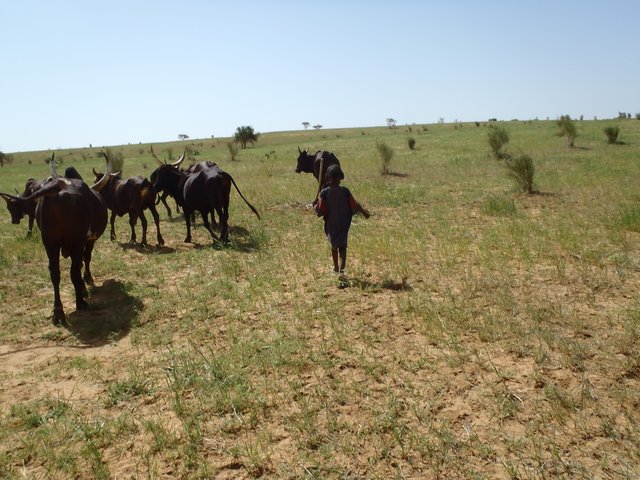
Pastoralism in Niger: monitoring system for movements and … [Niger]
This approach, traditional in nature and supported by the National Mechanism for the Prevention and Management of Disasters and Food Crises (DNPGCCA), consists of a Geographical Information System, which integrates the water resources, the movement of populations, and the spatial distribution of grazing land, also in terms of the quantities …
- Compiler: Soumaila Abdoulaye
2. Description of the SLM Technology
2.1 Short description of the Technology
Definition of the Technology:
Assisted Natural Regeneration (ANR) in pastoral zones is a simple and low-cost agroforestry technique. It involves locating and preserving shoots from stumps of woody and herbaceous vegetation on communal land used for agro-pastoralism, sylvo-pastoralism or pastoralism. The aim is to accelerate the process of natural regeneration resulting from natural seedlings or from sprouting stumps inherently present in the area.
2.2 Detailed description of the Technology
Description:
Assisted Natural Regeneration (ANR) is an agroforestry technique applied in areas affected by water and wind erosion on cropped fields as well as agro-pastoral and sylvo-pastoral land. Erosion results from (i) tree felling in fields and the clearing of seedlings, (ii) over-exploitation of land, and (iii) the process of desertification. Local populations in the pastoral zone of Niger include mainly transhumant livestock keepers and/or pastoralists (Tuareg, Bororo Peulh, Arabs and Toubou) who derive their income from the use of natural resources. People in the Sahelo-Saharan region have developed local know-how about sustainable land management, notably the practice of assisted natural regeneration on land that is exclusively set aside for grazing.
The significant growth of the population is dramatically increasing pressure on natural resources. In combination with the impacts of climate change and desertification, the process of land degradation has accelerated, resulting in chronic deficits in food and forage throughout the country. Facing these multiple environmental and ecological challenges, the state and its development partners have been testing and refining the technology of ANR since the 1990s. Assisted Natural Regeneration involves accelerating the process of natural regeneration of vegetation resulting from natural seedlings or from stumps inherently present in the area. Shoots from tree stumps with living root systems grow faster than seedlings derived from seeds. In the agricultural zone, ANR is a technique suited to improved land clearing, which involves locating and preserving shoots from stumps of desirable species of woody and herbaceous vegetation during the process of opening of land for cultivation. In addition to the protection of the shoots, selected species can be planted or sown through ‘enrichment planting’. The sprouts to be protected in the fields are identified during weeding. Weak stems are pruned out and fertile conditions created for development of the plants. On sylvo-pastoral communal land this results in an increase of desirable vegetation species with the best potential for ANR. These include those with a strong ability to sprout from roots (Balanites aegyptiaca, Faidherbia albida, Bombax costatum, Cassia sieberiana, Crateva adansonii, Detarium microcarpum, etc.) or those that can be propagated by layering (Guiera senegalensis, Combretum micranthum, Pterocarpus erinaceus, etc.).
In the pastoral zone the practice was developed by livestock keepers to optimize the length of the grazing period during transhumance. Techniques employed are tree trimming, selection of the livestock routes for transhumance to enhance ANR through the movement of animals, monitoring and protection of palatable species, seeding of local forage crops in areas with low vegetative cover, and protection of particular species that enhance the development of understory vegetation.
An increasing number of development projects are trying to develop local practices of ANR, especially in the northern part of the region of Tahoua and in the southern part of the region of Agadez. The main objectives of ANR are: (i) protection of cropland through erosion control (water and wind erosion), (ii) improvement of soil fertility, (iii) production of firewood or timber, (iv) production of forage for livestock, (v) reduction of evapotranspiration, and (vi) restoration and preservation of forage resources in the pastoral zone.
The following results are expected for the agricultural and agro-sylvo-pastoral zones: (i) a significant increase of woody biomass for energy provision, forage and timber, (ii) an increase in agricultural yields, and (iii) new sources of income enabling farmers to improve their living standards. Results expected for the pastoral zone include: (i) conservation and preservation of palatable vegetation species for livestock in the grazing areas, (ii) an increase in forage resources and woody biomass, and (iii) restoration of the vegetation cover on degraded pastoral land.
ANR requires labour and hand tools (hoes and machetes). The low costs of implementation and maintenance are the major advantage of this technology; these explain the ease of adoption and the broad dissemination among agro-pastoralists and livestock keepers. However, due to the lack of regular monitoring of achievements and the weak enforcement of laws that regulate the management of forest resources, the ecological and socio-economic impacts of ANR in Niger are limited, especially in the pastoral zone.
2.3 Photos of the Technology
General remarks regarding photos:
These photographs show that the technology performs several functions both in the agropastoral zone and in the pastoral regions in the north of the country.
2.4 Videos of the Technology
Comments, short description:
Videos of the technology are not available.
2.5 Country/ region/ locations where the Technology has been applied and which are covered by this assessment
Country:
Niger
Region/ State/ Province:
Urban municipality of Abalak, Department of Abalak, Region of Tahoua
Further specification of location:
Urban municipality of Abala, Department of Abala, Region of Tillabéri
Specify the spread of the Technology:
- evenly spread over an area
If precise area is not known, indicate approximate area covered:
- > 10,000 km2
Comments:
The technology is applied in the pastoral zones of the northern regions of Tillabéri, Tahoua, Maradi and Zinder. It is also applied in the region of Diffa and in the south of the region of Agadez. In all the southern regions, the technology is applied in agricultural fields and on communal land in use for sylvo-pastoralim.
ANR has been implemented in several regions in Niger: Maradi, Dosso, Zinder and Tillabéri. In the pastoral zone, ANR is particularly applied in the departments of Abalak, Abala and Belbédji. These applications were performed by livestock keepers individually on communal land and by organisations of producers. In the departments of Belbédji and Abalak, the population is supported by development projects and local NGOs.
Map
×2.6 Date of implementation
Indicate year of implementation:
2010
If precise year is not known, indicate approximate date:
- less than 10 years ago (recently)
2.7 Introduction of the Technology
Specify how the Technology was introduced:
- through land users' innovation
- through projects/ external interventions
Comments (type of project, etc.):
The technology is developed by livestock keepers and is part of pastoralist practices; it was implemented by agro-pastoralists in agricultural areas. Livestock keepers apply the principles of assisted natural regeneration in their regions of origin or during the transhumance, by conserving woody and herbaceous vegetation. Over the last twenty years, development projects on sustainable land management have developed this technology first in the agricultural area at field level. Then, in recent years projects are implementing the technology on sylvo-pastoral land in the agro-pastoral zones in southern Niger.
3. Classification of the SLM Technology
3.1 Main purpose(s) of the Technology
- improve production
- reduce, prevent, restore land degradation
- conserve ecosystem
- preserve/ improve biodiversity
- adapt to climate change/ extremes and its impacts
- mitigate climate change and its impacts
- create beneficial economic impact
- create beneficial social impact
3.2 Current land use type(s) where the Technology is applied
Land use mixed within the same land unit:
Yes
Specify mixed land use (crops/ grazing/ trees):
- Agro-silvopastoralism

Cropland
- Annual cropping
Annual cropping - Specify crops:
- cereals - millet
- cereals - sorghum
- legumes and pulses - peas
Number of growing seasons per year:
- 1
Specify:
In the agropastoral zone there are two growing seasons: the rainy season from May to September and the dry season from November to March/April. In the pastoral zone, the main growing season is the rainy season (May to September). Irrigated crops in the depressions and valley-bottoms are produced from November to April.

Grazing land
Extensive grazing:
- Nomadism
- Semi-nomadic pastoralism
Animal type:
- goats
- camels
- mules and asses
- cattle

Forest/ woodlands
Products and services:
- Timber
- Grazing/ browsing
Comments:
Main animal species and products: The main animal species found in the pastoral zone are: cattle, dromedaries, sheep, goats and donkeys. In this zone, the implementation of ANR is part of the management framework for herds and forage resources. The mentioned animal species are also found in the agro-pastoral zone in the south, but with many more equine animals.
In the agro-pastoral zones, the technology is applied on land primarily used for the production of millet, sorghum, cowpea, and cash crops; it is applied on land in use for agro-sylvo-pastoralism, sylvo-pastoralism and agro-pastoralism. Several development projects combine ANR with the development of markets for wood and forage. In these areas, agriculture, livestock and the trade of agro-pastoral products (livestock, cereals) are the main activities of local populations.
In Niger ANR is applied both on an individual basis at the field level and on communal land with the participation of the entire local population. The technology can be implemented on all types of land. The objectives of ANR depend on the types of land to which it is applied.
Livestock density: In the pastoral zone of the urban municipality of Abalak, the livestock density was estimated at 50 TLU/km2 in 2016. This density is found in the northern parts of the regions of Tillabéri, Maradi and Zinder, and in the south of the region of Agadez.
3.3 Has land use changed due to the implementation of the Technology?
Has land use changed due to the implementation of the Technology?
- Yes (Please fill out the questions below with regard to the land use before implementation of the Technology)
Comments:
Implementation of ANR on communal land requires secure land tenure to avoid any change in property rights.
3.4 Water supply
Water supply for the land on which the Technology is applied:
- mixed rainfed-irrigated
Comments:
The water supply in the pastoral zone is mainly dependent on precipitation. There is also an extensive network of pastoral wells and pumping stations in the grazing areas which are most intensively used. There is a horticultural system with irrigated crops in the valley bottoms and depressions. In the agricultural zone, irrigated and rainfed cropping alternate over the year.
3.5 SLM group to which the Technology belongs
- agroforestry
- pastoralism and grazing land management
- improved ground/ vegetation cover
3.6 SLM measures comprising the Technology

agronomic measures
- A7: Others

vegetative measures
- V1: Tree and shrub cover
- V2: Grasses and perennial herbaceous plants
- V5: Others
Comments:
On agricultural fields, ANR is used as an agronomic practice to improve the system of land clearing. It is also a vegetative measure to improve the cover of trees and shrubs. In the pastoral zone, the technology fulfills all these functions, especially the functions to improve the vegetation cover and to produce forage.
3.7 Main types of land degradation addressed by the Technology

soil erosion by water
- Wt: loss of topsoil/ surface erosion
- Wg: gully erosion/ gullying

soil erosion by wind
- Et: loss of topsoil
- Ed: deflation and deposition

chemical soil deterioration
- Cn: fertility decline and reduced organic matter content (not caused by erosion)

biological degradation
- Bc: reduction of vegetation cover
- Bh: loss of habitats
- Bq: quantity/ biomass decline
- Bs: quality and species composition/ diversity decline
Comments:
ANR addresses several types of land degradation which threaten the soil fertility and the production of forage. The practice integrates an enhanced support to the regeneration of plants and vegetation cover with the aim to control the most frequently occurring types of soil erosion in the countries of the Sahel.
3.8 Prevention, reduction, or restoration of land degradation
Specify the goal of the Technology with regard to land degradation:
- prevent land degradation
- reduce land degradation
Comments:
Apart from preventing and reducing land degradation, ANR also contributes to the restoration and rehabilitation of degraded land, that otherwise would have required considerable investments. In that case ANR is linked to the closure of certain areas for grazing to enable a full recovery of the land.
4. Technical specifications, implementation activities, inputs, and costs
4.1 Technical drawing of the Technology
Technical specifications (related to technical drawing):
Sketch 1 shows tree seedlings which are pruned to fewer stems to enhance development.
Author:
PASADEM, Maradi, Niger
Date:
18/08/2015
Technical specifications (related to technical drawing):
Sketch 2 presents the structure of a patch of doum palm seedlings, showing the interdependence between the different sprouts.
Author:
Peltier Régis, Claudine Serre Duhem and Aboubacar Ichaou.
Date:
06/04/2008
Technical specifications (related to technical drawing):
Sketch 3 presents a scheme for a doum palm plantation in the agricultural zone, in an arrangement of cells with trees in various stages of regeneration over a period of 30 years.
Author:
Peltier Régis, Claudine Serre Duhem and Aboubacar Ichaou.
Date:
06/04/2008
4.2 General information regarding the calculation of inputs and costs
Specify how costs and inputs were calculated:
- per Technology area
Indicate size and area unit:
1 hectare
other/ national currency (specify):
West African CFA francs
If relevant, indicate exchange rate from USD to local currency (e.g. 1 USD = 79.9 Brazilian Real): 1 USD =:
500.0
Indicate average wage cost of hired labour per day:
1500 CFA francs
4.3 Establishment activities
| Activity | Timing (season) | |
|---|---|---|
| 1. | Awareness-raising among the population and demonstrations of ANR techniques in villages | In the dry season, at the start of the project (preferably in January-February) |
| 2. | Set-up of an organisational structure to promote ANR based on village committees, and training of committee members in: identifying, protecting and nurturing seedlings (derived from seeds, tree sprouts, shoots, layers, etc.). | Immediately after the awareness-raising and before the start of the rainy season |
| 3. | Early intervention to enhance the regeneration and treatment of seedlings | At the start of the rainy season, after the establishment of the supervisory committees |
| 4. | Develop vegetative propagation of species with potential for ANR | During the rainy season |
Comments:
These activities are part of the implementation of a development project. If ANR is implemented spontaneously, the agropastoralist or livestock keeper directly initiates ANR without an awareness campaign or supervisory committee in place.
4.4 Costs and inputs needed for establishment
| Specify input | Unit | Quantity | Costs per Unit | Total costs per input | % of costs borne by land users | |
|---|---|---|---|---|---|---|
| Labour | skilled labour | person-days | 1.0 | 21000.0 | 21000.0 | |
| Labour | unskilled labour | person-days | 14.0 | 1500.0 | 21000.0 | 100.0 |
| Equipment | Small equipment (machete, hoe, short-handled hoe, etc.) | set | 1.0 | 3000.0 | 3000.0 | 100.0 |
| Total costs for establishment of the Technology | 45000.0 | |||||
| Total costs for establishment of the Technology in USD | 90.0 | |||||
If land user bore less than 100% of costs, indicate who covered the remaining costs:
In case the implementation of the technology was conducted in the context a development project, only the costs of training are not borne by the land user, but covered by the project. In some cases the project also provides technical support, such as the installation of a tree nursery or food distribution.
Comments:
The total costs are indicated for the establishment of ANR through a development project. When the land user accomplishes ANR himself, the costs are 24.000 CFA francs/hectare, that is the costs for labour and depreciation of equipment. Labour costs represent almost 90% of the total costs for establishment of the technology. The costs for installation of a nursery are not included in the cost calculations. In the strict sense, ANR is not combined with the production of nursery plants.
4.5 Maintenance/ recurrent activities
| Activity | Timing/ frequency | |
|---|---|---|
| 1. | Base pruning: meaning cutting a tree close to the soil surface to encourage sprouts to shoot. | Before the start of the rainy season, during the period from March to May. |
| 2. | 2.Pruning trees: comprising cutting off excess and weak branches. | Tree pruning must be performed right after the establishment of crops. |
| 3. | 3.Trellising: involving driving one or more posts into the ground to support the selected shoot. | During the rainy season. |
| 4. | 4.In agricultural areas, protecting species which are palatable, and species which are not resistant to grazing. | Throughout the rainy season until the crop harvesting. |
Comments:
Maintenance work is generally performed by the land users. On sylvo-pastoral land maintenance is carried out by the community and continues throughout the year, but it is most important in the period with precipitation. In the pastoral zone transhumant livestock keepers and nomadic people maintain the technology on an individual basis. In this region, maintenance involves optimizing the use of available forage resources, livestock rotation, and monitoring of the grazing land to enhance the natural regeneration of palatable vegetation species.
4.6 Costs and inputs needed for maintenance/ recurrent activities (per year)
| Specify input | Unit | Quantity | Costs per Unit | Total costs per input | % of costs borne by land users | |
|---|---|---|---|---|---|---|
| Labour | Unskilled labour | person-days | 34.0 | 1500.0 | 51000.0 | 100.0 |
| Equipment | Small equipment (hoe, machete, short-handled hoe) | set | 1.0 | 3000.0 | 3000.0 | 100.0 |
| Total costs for maintenance of the Technology | 54000.0 | |||||
| Total costs for maintenance of the Technology in USD | 108.0 | |||||
If land user bore less than 100% of costs, indicate who covered the remaining costs:
0
Comments:
The maintenance costs exceed the costs for establishment of the technology due to the efforts to secure the ownership of treated land throughout the year. Labour accounts for the major share of the costs. Operations are more intensive during maintenance compared to establishment of the technology. The production of nursery plants is not included in the cost estimation.
4.7 Most important factors affecting the costs
Describe the most determinate factors affecting the costs:
Labour is the key determinant of the costs for establishment and maintenance of the technology, representing almost 90% of the total costs.
5. Natural and human environment
5.1 Climate
Annual rainfall
- < 250 mm
- 251-500 mm
- 501-750 mm
- 751-1,000 mm
- 1,001-1,500 mm
- 1,501-2,000 mm
- 2,001-3,000 mm
- 3,001-4,000 mm
- > 4,000 mm
Specifications/ comments on rainfall:
The mean annual precipitation in the pastoral zone does not exceed 300 mm. In the southern regions of Niger (the Sahelian zone), annual precipitation is between 500 and 600 mm. Recent decades have been marked by a large variability in rainfall in space and time across Niger.
Indicate the name of the reference meteorological station considered:
meteorological stations of Abalak and Tillabéry
Agro-climatic zone
- semi-arid
The pastoral zone of Niger has a Sahelian-Saharan climate. The agro-pastoral regions of Niger are characterized by a Sahelian climate.
5.2 Topography
Slopes on average:
- flat (0-2%)
- gentle (3-5%)
- moderate (6-10%)
- rolling (11-15%)
- hilly (16-30%)
- steep (31-60%)
- very steep (>60%)
Landforms:
- plateau/plains
- ridges
- mountain slopes
- hill slopes
- footslopes
- valley floors
Altitudinal zone:
- 0-100 m a.s.l.
- 101-500 m a.s.l.
- 501-1,000 m a.s.l.
- 1,001-1,500 m a.s.l.
- 1,501-2,000 m a.s.l.
- 2,001-2,500 m a.s.l.
- 2,501-3,000 m a.s.l.
- 3,001-4,000 m a.s.l.
- > 4,000 m a.s.l.
Indicate if the Technology is specifically applied in:
- not relevant
Comments and further specifications on topography:
The topography of the intermediate Sahelian-Saharan strip includes dunes alongside valleys, which are fairly covered with woody vegetation in the part bordering the Sahelian zone. The Sahelian zone has multiple plains and valleys, glacis/plateaus and hills which are crossed by the river Niger in the southwestern part (550 km in Niger), and by several other streams.
5.3 Soils
Soil depth on average:
- very shallow (0-20 cm)
- shallow (21-50 cm)
- moderately deep (51-80 cm)
- deep (81-120 cm)
- very deep (> 120 cm)
Soil texture (topsoil):
- coarse/ light (sandy)
- medium (loamy, silty)
Soil texture (> 20 cm below surface):
- coarse/ light (sandy)
- medium (loamy, silty)
Topsoil organic matter:
- medium (1-3%)
- low (<1%)
5.4 Water availability and quality
Ground water table:
> 50 m
Availability of surface water:
poor/ none
Water quality (untreated):
poor drinking water (treatment required)
Is water salinity a problem?
No
Is flooding of the area occurring?
No
Comments and further specifications on water quality and quantity:
The depth of groundwater tables in the pastoral zone is well over 100 m and may frequently reach 500 m or more in the western part (Tchintabaraden). Surface water consists of temporary ponds. In the agro-pastoral zones in the south, groundwater is at more than 100 m depth. In the valleys and plains, groundwater is often found at less than 5 m depth. This zone is characterized by several permanent and ephemeral water courses.
5.5 Biodiversity
Species diversity:
- medium
Habitat diversity:
- medium
Comments and further specifications on biodiversity:
Niger has been one of the main reservoirs of biodiversity in Africa. Over the past five decades, the accelerated degradation of ecosystems has significantly reduced the biodiversity. The degradation is the result of successive droughts and a process of accelerated desertification on the one side, and of population growth leading to a significant pressure on natural resources and/or land on the other side. Several species of vegetation and wildlife have disappeared, while others are in danger of extinction in the coming years despite the national strategies for conservation, protection and restoration implemented by the government authorities and their development partners.
Several restrictions were observed with regard to the management of biodiversity in Niger: (i) insufficient knowledge on biodiversity and biodiversity components, (ii) a lack of specific programs and projects related to biodiversity, (iii) inappropriate legislation on biodiversity, (iv) the failure to involve the populations in the management of biodiversity, (v) insufficient and inappropriate awareness raising, information campaigns and training, (vi) the lack of consideration given to biodiversity in the design and implementation of development measures, (vii) adverse climate conditions, (viii) multiple and increasing pressures on biodiversity and its components, (ix) a high population growth with an uneven spatial distribution, not corresponding to the land capability of the different areas, (x) difficult access to certain isolated regions and regions with steep slopes, (xi) difficult access to water due to topographical and geological constraints.
5.6 Characteristics of land users applying the Technology
Sedentary or nomadic:
- Sedentary
- Semi-nomadic
Market orientation of production system:
- mixed (subsistence/ commercial)
Off-farm income:
- less than 10% of all income
Relative level of wealth:
- very poor
- poor
Individuals or groups:
- individual/ household
- cooperative
Level of mechanization:
- manual work
- animal traction
Gender:
- women
- men
Age of land users:
- youth
- middle-aged
Indicate other relevant characteristics of the land users:
Since the late 1990s accelerated urbanization has occurred in the pastoral zone. On the one side, sequential droughts have turned several livestock keepers into simple herders, whereas others preferred to leave the pastoral zone to start new activities in the urban centres. On the other side, the high population growth has forced several families to settle and to diversify their economic activities. Agriculture is increasingly developing beside pastoralism. Similarly, while local populations in the agro-pastoral zone in the south are adapting to climate change, this process has led them to diversify their economic activities. They are increasingly moving towards off-farm activities such as trade. Poor or vulnerable people represent most of the population in all these regions, or almost 60% of the total population. Extremely poor people represent nearly 30% of the total population. The laws on pastoralism are founded on a community-based management of natural resources in the pastoral zone. But since the late 2000s private ranches appeared in this area. The settlement of population groups is leading to the issuing of titles on private land and to land fragmentation around rapidly developing urban centres. Production systems are based on human capital and traditional basic equipment; animal traction is widely used, mainly in the horticultural sector (the camel being the primary animal used for water pumping). Women rarely participate in the production; young and middle-aged men who offer their labour force are the main workers. It should be noticed that among the Tuareg and Bororo Peulh people children drive herds to the grazing areas. In the agro-pastoral zones in the south, men and women work in the fields and perform livestock activities and trade. In these regions children are working from the age of 5. By working in the fields, they provide labour to their parents. There is no process of mechanization in the production systems. Production activities are usually managed in the context of households which function as basic family businesses.
5.7 Average area of land used by land users applying the Technology
- < 0.5 ha
- 0.5-1 ha
- 1-2 ha
- 2-5 ha
- 5-15 ha
- 15-50 ha
- 50-100 ha
- 100-500 ha
- 500-1,000 ha
- 1,000-10,000 ha
- > 10,000 ha
Is this considered small-, medium- or large-scale (referring to local context)?
- small-scale
Comments:
The areas in the pastoral zone treated by livestock keepers are communal and extend over thousands of hectares. In the agro-pastoral zone the size of fields varies between 0.5-1 and 2-5 hectares. Fields are fragmented due to the high population growth. Communal land in use for sylvo-pastoralism generally covers more than 15 hectares.
5.8 Land ownership, land use rights, and water use rights
Land ownership:
- state
- communal/ village
Land use rights:
- communal (organized)
- individual
Water use rights:
- communal (organized)
- individual
Comments:
The use of communal land for pastoralism is regulated by the laws on pastoralism, which are an integral part of the rural code of Niger. Land in the pastoral zone is owned by the communities and by the State. The pumping stations, drill holes and pastoral wells are the main sources of water supply in the pastoral zone. This infrastructure generally remains the property of the State, and is placed under the responsibility of the municipalities. There is also privately owned infrastructure (wells and drill holes). In contrast, land ownership in the agro-pastoral zone in the south is typically private (with and without land title deeds); there is some communal land that is regulated by the rural code. Land use rights are usually individual (family rights). Water use rights are mostly individual and organized at the level of the community.
5.9 Access to services and infrastructure
health:
- poor
- moderate
- good
education:
- poor
- moderate
- good
technical assistance:
- poor
- moderate
- good
employment (e.g. off-farm):
- poor
- moderate
- good
markets:
- poor
- moderate
- good
energy:
- poor
- moderate
- good
roads and transport:
- poor
- moderate
- good
drinking water and sanitation:
- poor
- moderate
- good
financial services:
- poor
- moderate
- good
6. Impacts and concluding statements
6.1 On-site impacts the Technology has shown
Socio-economic impacts
Production
crop production
Quantity before SLM:
50 kg/ha
Quantity after SLM:
100 kg/ha
Comments/ specify:
In the agro-pastoral zone, the application of ANR in fields has increased the cereal production (millet, sorghum) by almost 50%. On less fertile land the production increased by more than 100%.
fodder production
Quantity after SLM:
50%
Comments/ specify:
The vegetation cover on sylvo-pastoral land has increased by more than 100%. The fodder production is estimated to have increased by at least 50%. In the pastoral zone the application of ANR has increased the fodder production by nearly 50%.
fodder quality
Quantity after SLM:
25%
Comments/ specify:
On sylvo-pastoral land in the south, the application of ANR to enhance selected species, in particular the doum palm, is thought to have improved the fodder quality through the development of palatable vegetation species. In the pastoral zone in the north, the technology enabled to maintain the fodder quality in the areas of transhumance.
animal production
Quantity after SLM:
50%
Comments/ specify:
The application of ANR contributes to the increase of the livestock production in pastoral and sylvo-pastoral land in the south by nearly 20%. In the pastoral zone ANR has increased livestock production by at least 20%.
wood production
Quantity after SLM:
50%
Comments/ specify:
In the south of the country an increase in the production of wood by at least 50% was observed following the implementation of ANR. It should be noted that this production increase was promoted by the planting of woody species in the sites where ANR was applied.
Income and costs
diversity of income sources
Quantity after SLM:
100%
Comments/ specify:
The application of ANR promotes trade in timber, other forest products and hay/straw in the agro-pastoral zone. In several cases the trade is combined with the production of seedlings in nurseries, which are sold to land users. In the pastoral zone ANR has led to the marketing of forest products (e.g. gum arabic from acacia trees) and hay/straw in some regions. In addition ANR enhances dairy production and the production of cheese.
economic disparities
Quantity after SLM:
In the short term there is no evident impact.
Comments/ specify:
ANR contributes to reducing economic disparities between vulnerable and wealthy land users in the medium and long term. In the pastoral zone, ANR benefits the entire population. This applies especially to the poorest livestock keepers, who lack the financial resources to buy imported animal feed.
Socio-cultural impacts
food security/ self-sufficiency
Quantity after SLM:
20%
Comments/ specify:
ANR contributes to food security and food self-sufficiency in the southern regions of the country. The impact is estimated at 20% at least. In the pastoral zone in the north, ANR can reduce forage deficits. In this way, the technology reduces hardship to livestock keepers in the lean season, and prevents them from being forced to sell their animals.
community institutions
Quantity after SLM:
100%
Comments/ specify:
In the agro-pastoral zone in the south the implementation of ANR has led to the creation of community-based organizations, for example the committees for management and supervision. Organizations of livestock keepers in the pastoral zone have been strengthened by the establishment of committees. Similarly, traditional associations strengthen their capacities by diversifying their activities relating to the implementation of ANR.
SLM/ land degradation knowledge
Quantity after SLM:
100%
Comments/ specify:
Project interventions entail the setting up of training programs, both in the north and the south of the country, to enable land users to increase their knowledge of SLM. In the pastoral zone existing local knowledge is used and innovations by livestock keepers are promoted.
conflict mitigation
Quantity after SLM:
100%
Comments/ specify:
ANR mitigates conflicts about timber management in the southern regions by establishing community arrangements. In the pastoral zone the technology contributes to conflict mitigation on forage resources by creating an environment for knowledge sharing and compliance with the regulations in force.
situation of socially and economically disadvantaged groups
Quantity after SLM:
50%
Comments/ specify:
ANR improves the situation of vulnerable producers by ensuring the increase of farm and livestock production, and also off-farm income. The technology allows smallholder farmers to increase their yields and to access expanding forest resources.
Ecological impacts
Soil
soil cover
Quantity after SLM:
100%
Comments/ specify:
ANR leads to a substantial increase of the vegetation cover. It promotes the return of some herbaceous species on unproductive land, and especially the suppression of invasive plants which are unsuitable for livestock.
soil organic matter/ below ground C
Quantity after SLM:
100%
Comments/ specify:
A rapid and significant increase of soil organic matter was observed in the short term. Practices of livestock rotation in the grazing areas of the pastoral zone increase the soil organic matter significantly, and maintain soil fertility on a sustainable basis.
Biodiversity: vegetation, animals
Vegetation cover
Quantity after SLM:
100%
Comments/ specify:
The main impact of ANR in the regions where it is applied is the increase of the vegetation cover. On pastoral and sylvo-pastoral land the increase is rapid and particularly strong.
biomass/ above ground C
Quantity after SLM:
100%
Comments/ specify:
Above-ground biomass increases especially on pastoral and sylvo-pastoral land. An increase is also observed in agricultural fields, mainly due to the high density of woody vegetation.
plant diversity
Quantity after SLM:
100%
Comments/ specify:
The application of ANR in combination with the planting of selected tree species in the agro-pastoral region enhances plant diversity, particularly when herbaceous species are reintroduced which had disappeared from the area.
invasive alien species
Quantity after SLM:
100%
Comments/ specify:
The PASADEM project has joined the implementation of ANR with the control of Sida cordifolia, an invasive species which is undermining the grazing land in the region of Maradi.
Climate and disaster risk reduction
drought impacts
Quantity after SLM:
30%
Comments/ specify:
By improving the vegetation cover and increasing the production of woody vegetation, ANR helps to reduce the impacts of long droughts during the rainy season.
6.2 Off-site impacts the Technology has shown
buffering/ filtering capacity
Quantity after SLM:
100%
Comments/ specify:
By increasing the vegetation cover, ANR significantly improves the buffer and filtering capacities of the soil, especially through the development of woody species. In this way the technology helps to control water erosion (rills and gullies), which is typical of these regions.
Specify assessment of off-site impacts (measurements):
The impact assessment is mainly based on observations from the regions of Maradi (department of Maradi), Tillabéri (departments of Kollo and Abala) and Tahoua (departments of Abalak and Tchintabaraden). The impact of ANR is limited in the short term. However, in the medium and long term the effects are highly significant both with regard to vegetation cover and to the development of woody species. Hence the technology is very sensitive to climate change, which reduces the ecological and economic impacts.
6.3 Exposure and sensitivity of the Technology to gradual climate change and climate-related extremes/ disasters (as perceived by land users)
Gradual climate change
Gradual climate change
| Season | increase or decrease | How does the Technology cope with it? | |
|---|---|---|---|
| annual temperature | increase | not well | |
| seasonal temperature | dry season | increase | not well |
| annual rainfall | decrease | not well | |
| seasonal rainfall | wet/ rainy season | decrease | not well |
Climate-related extremes (disasters)
Meteorological disasters
| How does the Technology cope with it? | |
|---|---|
| local sandstorm/ duststorm | moderately |
| local windstorm | moderately |
| tornado | moderately |
Climatological disasters
| How does the Technology cope with it? | |
|---|---|
| drought | not well |
Other climate-related consequences
Other climate-related consequences
| How does the Technology cope with it? | |
|---|---|
| reduced growing period | moderately |
Comments:
According to all land users, ANR remains very sensitive to gradual change and to extreme events or disasters related to climate change, both in the pastoral zone and in the agro-pastoral regions in the south. The high variability of precipitation has negatively influenced the impact of ANR in all regions in Niger.
6.4 Cost-benefit analysis
How do the benefits compare with the establishment costs (from land users’ perspective)?
Short-term returns:
slightly positive
Long-term returns:
very positive
How do the benefits compare with the maintenance/ recurrent costs (from land users' perspective)?
Short-term returns:
slightly positive
Long-term returns:
very positive
Comments:
The establishment and maintenance costs of ANR are very low. Therefore the short-term returns are still slightly positive. In the pastoral zone observations show positive returns of the technology, even in the short term. The impacts are clearer in the medium and long term, and the cost-effectiveness is highest at these time scales.
6.5 Adoption of the Technology
- 11-50%
If available, quantify (no. of households and/ or area covered):
The majority of transhumant livestock keepers in the pastoral zone (60%) have adopted ANR over an area of approximately 2,000 km2 of grazing land. In the agro-pastoral zone within the regions of Tillabéri, Maradi and Tahoua the area treated with ANR exceeds 10,000 km2
Of all those who have adopted the Technology, how many did so spontaneously, i.e. without receiving any material incentives/ payments?
- 91-100%
Comments:
Most development projects implementing ANR do not provide material or financial incentives. In the pastoral zone the technology must be applied in conditions without external support by relying on local know-how.
6.6 Adaptation
Has the Technology been modified recently to adapt to changing conditions?
Yes
If yes, indicate to which changing conditions it was adapted:
- climatic change/ extremes
Specify adaptation of the Technology (design, material/ species, etc.):
Several projects have adapted ANR by complementing the implementation with tree planting and seeding local or external forage species in sylvo-pastoral land. Some projects have combined the technology with the control of invasive plant species and plants that are harmful to livestock. ANR is based on the selection of species that have high potential for the production and marketing of forage and timber.
6.7 Strengths/ advantages/ opportunities of the Technology
| Strengths/ advantages/ opportunities in the land user’s view |
|---|
| The strength of ANR is that the technology is easy to implement and maintain, and therefore entails very low costs. This has led to the widespread adoption of the technology in all regions. |
| The second strength is the improvement of soil fertility and the increase of crop and fodder yields. The improved soil fertility leads to an increase in production and improved food security, both for humans and livestock. |
| The third strength is that resources are being renewed, and that needs for timber and forage are met. According to land users, these supplementary resources enable them to improve their living standards. |
| Strengths/ advantages/ opportunities in the compiler’s or other key resource person’s view |
|---|
| The ease of adoption, which has enabled the dissemination of the technology across the country. The technology is a local innovation, which was disseminated and scaled-up by development projects. The implementation and maintenance are in line with the project cycle. |
| The effect of ANR in reducing the evaporation of soil moisture is a major strength in a Sahelian country like Niger. The ANR technology has positive impacts on the vegetation cover, the soil biodiversity and the density of woody vegetation. These constitute a major advantage in a region subject to accelerated desertification and to the effects of almost chronic droughts. |
| Conservation and restoration of the environment through ANR are a major advantage in this region of the Sahel, which faces accelerated environmental degradation due to human activities and climate change. |
6.8 Weaknesses/ disadvantages/ risks of the Technology and ways of overcoming them
| Weaknesses/ disadvantages/ risks in the land user’s view | How can they be overcome? |
|---|---|
| The impacts of investments in the technology are only significant in the medium and long term. A long period is required to benefit from the results. | Land users should be supported by implementing the technology in the first year in which ANR is adopted, in the form of cash or food for work. |
| The technology requires that tenure of fields and sylvo-pastoral land are secure. | Establishing community-based brigades to supervise the land under treatment. |
| Weaknesses/ disadvantages/ risks in the compiler’s or other key resource person’s view | How can they be overcome? |
|---|---|
| Illegal logging both in the fields and in the grazing areas. | Establish a communal system to supervise treated areas in partnership with all stakeholders. |
| Lack of a monitoring mechanism and of guidelines for the rational use of resources. | The land commissions at the local level and at the level of villages or tribes should be supported to establish community-based mechanisms to supervise and monitor the implementation of laws on pastoralism, and of the rural code in general. |
| Lack of legislation on forestry incorporating the status of regenerating trees in fields and in the pastoral zone. | The legislation in force should be adapted to the context resulting from the implementation of ANR in fields and in the pastoral zone. |
7. References and links
7.1 Methods/ sources of information
- field visits, field surveys
Since 2016, field visits have been organized at the end of each quarter in the regions of Tahoua and Tillabéri in the framework of several development projects. In the region of Maradi, PASADEM organizes periodic field visits. Around ten men and women are interviewed (a majority of men).
- interviews with land users
In the period 2014-2016, land users in the pastoral zone of Tahoua and Abala have been interviewed each year using questionnaires. In the department of Abalak, 11 local livestock keepers were interviewed and 9 women. In the department of Abala, around thirty transhumant livestock keepers were interviewed. Several tens of farmers and transhumant livestock keepers were interviewed in the regions of Tillabéri, Maradi, Dosso and Tahoua during the implementation of several projects.
- interviews with SLM specialists/ experts
Interviews were conducted with around ten SLM specialists who were involved in the context of several development projects.
- compilation from reports and other existing documentation
Monitoring and evaluation reports of development projects have been used, documents on the Internet, research reports and academic papers.
When were the data compiled (in the field)?
01/07/2015
7.2 References to available publications
Title, author, year, ISBN:
Valoriser les produits du palmier doum pour gérer durablement le système agroforestier d'une vallée sahélienne du Niger et éviter sa désertification, Peltier Régis, Claudine Serre Duhem and Aboubacar Ichaou, 2008
Available from where? Costs?
document available for download on the Internet
Title, author, year, ISBN:
Note de capitalisation « Expérience du Programme Niger FIDA dans la mise á l’échelle de la Régénération Naturelle Assistée (RNA) », PASADEM, 2015
Available from where? Costs?
PASADEM, GREAD
Title, author, year, ISBN:
Etude de Cas: Régénération Naturelle Assistée (RNA) dans la région de Maradi (Niger), Abdoulaye Sambo Soumaila, 2015
Available from where? Costs?
GREAD
7.3 Links to relevant online information
Title/ description:
aucun lien
URL:
aucun lien
Links and modules
Expand all Collapse allLinks

Pastoralism in Niger: monitoring system for movements and … [Niger]
This approach, traditional in nature and supported by the National Mechanism for the Prevention and Management of Disasters and Food Crises (DNPGCCA), consists of a Geographical Information System, which integrates the water resources, the movement of populations, and the spatial distribution of grazing land, also in terms of the quantities …
- Compiler: Soumaila Abdoulaye
Modules
No modules


